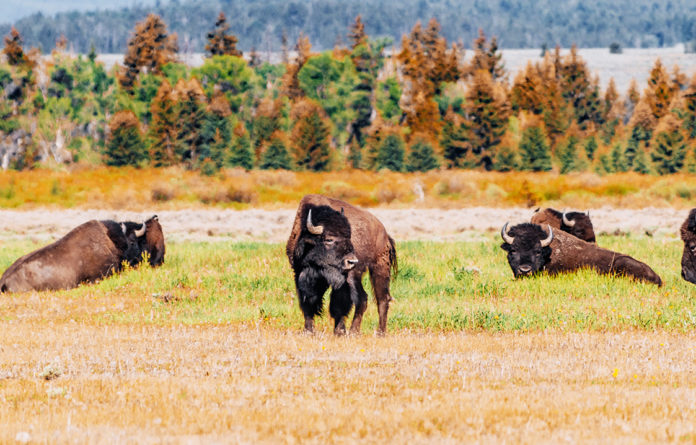WASHINGTON, D.C. – The Department of the Interior has announced several new steps to restore wild and healthy populations of American bison and the prairie grassland ecosystem. Through a new Secretary’s Order and over $25 million from the Inflation Reduction Act, the Department will empower its bureaus and partners to use the best available science and Indigenous knowledge to help restore bison across the country.
“The American bison is inextricably intertwined with Indigenous culture, grassland ecology and American history,” said Secretary Deb Haaland. “While the overall recovery of bison over the last 130 years is a conservation success story, significant work remains to not only ensure that bison will remain a viable species but also to restore grassland ecosystems, strengthen rural economies dependent on grassland health and provide for the return of bison to tribally owned and ancestral lands. New historic funding from the Inflation Reduction Act will help support the Department’s efforts to restore this iconic species and integrate Indigenous knowledge into our shared stewardship goals.”
American bison once numbered 60 million in North America, with the population anchored in what is now the central United States. Many Indigenous cultures, especially in areas where the species was most abundant, developed strong ties with bison and relied upon them for sustenance, shelter, and cultural and religious practices. In the 19th century, bison were nearly driven to extinction through uncontrolled hunting and a U.S. policy of eradication tied to intentional harm against and control of tribes. By 1889, only a few hundred wild bison remained. The persecution of bison contributed to the decline of healthy grassland ecosystems and, eventually, to the Dust Bowl in the 1930’s. The loss of the keystone species, coupled with land conversion, led to declines of other important grassland wildlife, such as migratory birds and pollinators.
Beginning in the early 20th century with the support of President Theodore Roosevelt, conservationists and scientists made a collective effort to restore the American bison. Since then, careful conservation and restoration efforts have increased the number of wild bison in the United States from fewer than 500 to more than 15,000. The Interior Department currently manages 11,000 bison in herds across 4.6 million acres of U.S. public lands in 12 states.
While the security of the species is a conservation success worth celebration, bison remain functionally extinct to both grassland systems and the human cultures with which they co-evolved. This announcement will help advance bison restoration efforts to grasslands, which can enhance soil development, restore native plants and wildlife, and promote carbon sequestration, providing benefits for agriculture, outdoor recreation, and tribes.
New Departmental Guidance To Restore Bison and Prairie Grassland Ecosystems
Secretary’s Order 3410 will enhance the Interior Department’s work to restore wild and healthy populations of American bison and the prairie grassland ecosystem through collaboration among Department bureaus and partners such as other federal agencies, states, tribes and landowners using the best available science and Indigenous knowledge.
The Order formally establishes a Bison Working Group (BWG), which will be composed of representation from the five bureaus with bison equities: the Bureau of Indian Affairs (BIA), Bureau of Land Management, U.S. Fish and Wildlife Service (FWS), National Park Service (NPS), and U.S. Geological Survey. The BWG will develop a Bison Shared Stewardship Plan, which will establish a comprehensive framework for American bison restoration, including strengthening long-term bison conservation partnerships. Central to the development of that plan will be robust engagement with tribes, including prioritizing tribally led opportunities to establish new large herds owned or managed by tribes and tribally led organizations.
The Order also directs the BIA to establish a Bison Management Apprenticeship program, in collaboration with the BWG, FWS and NPS. This new program will work to ensure that tribes that manage bison herds on their own lands or through co-stewardship agreements will benefit from training and knowledge sharing to support talent and capacity in their communities, including opportunities for hands-on experience supported by national parks and national wildlife refuges.
Funding from the Inflation Reduction Act to Promote Bison Restoration
The Department and its bureaus are committing over $25 million from the Inflation Reduction Act to promote bison conservation. This funding will go toward a variety of projects and initiatives, including establishing new bison herds, supporting bison transfers to tribes, and entering into co-stewardship agreements with tribes for bison management. The funding will also help improve the quality of grassland ecosystems, restore native plant communities, and support prescribed fire efforts.
The Inflation Reduction Act is a historic and transformational investment toward achieving President Biden’s ambitious goals to tackle the climate crisis while lowering costs for working families and creating good-paying jobs. Combined with the Bipartisan Infrastructure Law, these two initiatives represent the largest investments in climate resilience in the nation’s history and provide a once-in-a-generation opportunity for the work of the Interior Department.
A New Restoration and Resilience Framework to Bolster Climate Resilience
The announcement comes as the Department unveils a restoration and resilience framework to guide strategic investments, catalyze coordination, drive meaningful outcomes and advance climate resilience.
Through President Biden’s Bipartisan Infrastructure Law and the Inflation Reduction Act, the Department is implementing a more than $2 billion down payment to restore our nation’s lands and waters. This new framework will help ensure that investments from these two laws are focused strategically to solve key conservation challenges and advance climate resilience.














































